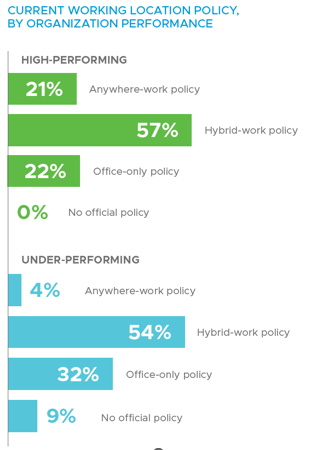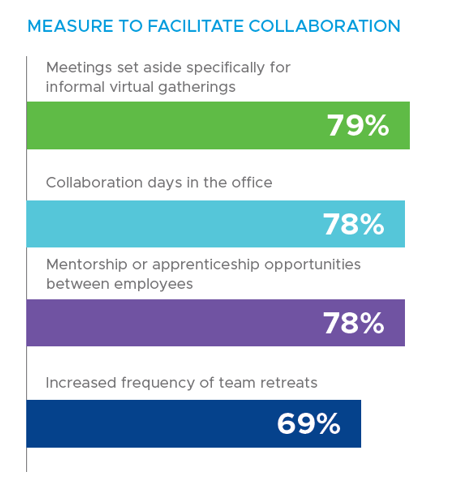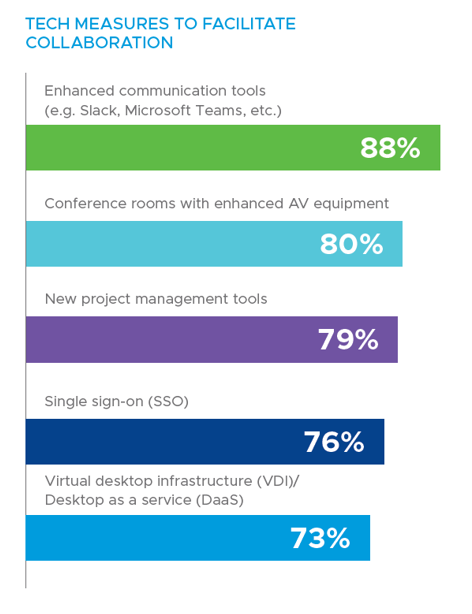Can innovation happen in a company if employees aren’t in an office? Can employees have job satisfaction when an employer mandates their work location?
Those are two important questions raised — and addressed quantitatively — by new research that VMware commissioned; the data comes from an impressive base of 5,300 HR, IT, and business decision makers, as well as employee-level respondents in nearly 20 countries and nearly 20 industries.
The data makes a significant contribution to important strategic analyses: how companies will innovate going forward, evolving work policies, the employer-employee relationship, and how businesses can operationalize innovation.
“Innovation prospers when employees are in the office, but job satisfaction goes up when employees can work from anywhere,” the report says in an executive summary. “This creates a ‘zero-sum conundrum’ for employers who want to spur innovation without crushing job satisfaction and losing the workers who are doing the innovating.”
Make the Most of Hybrid Work
The study lays out the current state of work policies among the companies in the respondent pool: the highest percentage by far — 64% — have hybrid work policies, while just 13% have office-only policies. Another 20% have work-from-anywhere policies.
It also delves into work policies by business performance category; it defines “high-performing” companies as those growing revenue by 15% or more per year, while “under-performing” companies are shrinking by 1% or more per year. Among high performers, 57% have a hybrid work policy and 22% have an office-only policy. Among lower performers, 32% have an office-only policy. Here’s the full distribution by performance level and work-location policy:

Office Time = Innovation?
One of the study’s more provocative sections is titled: “Innovation Happens in Person.” I label it provocative because it may spark plenty of debate or disagreement.
The study finds that 69% of “decision makers” say their organization is more innovative if employees are in the office. By comparison, 56% of employee-level respondents (who consistently say they prefer flexible or hybrid work) say their organizations are more innovative when working in an office.
When taken in total, 66% of respondents say their organization is more innovative with employees in the office; 75% of those in work-from-anywhere companies say they’re more innovative with employees in the office; 64% of hybrid-work respondents think so, and 69% of office-only respondents report greater innovation when employees are in the office.
The report also breaks out the responses by company size, and that data shows a significantly higher percentage of those in smaller companies see in-office work arrangements fueling innovation.

What Is Innovation, Exactly?
The study formally defines innovation and who’s measuring it, which lends more weight to the responses above.
Metrics used to measure innovation:
- Customer satisfaction: 42% of respondents measure this
- Improved performance of employees/teams: 36%
- Increased revenue: 36%
- Customer acquisition: 30%
- Speed at which products or updates are released to market: 29%
- New revenue streams: 28%
- Number of products or updates released to market: 26%
- Cost of releasing products or updates to market: 25%
- Number of patents filed: 18%
This looks like a great list, though I’d consider one item — improved performance of employees/teams — to be both difficult to measure and not a great indicator of innovation. The authors note: “If organizations track ‘team performance’ as a metric for innovation, then it makes sense to want teams in the office collaborating.”
But in my view, all the other metrics speak to ways that a company engages with and wins over customers in direct ways. Improved performance of employees could ultimately result in innovation, but the direct cause-effect relationship isn’t as clear or measured as reliably and consistently as the others.
Another fascinating finding: the percentage of companies by work policy that are, in fact, measuring innovation.
Among those with an anywhere-work policy, 97% are applying metrics. 93% of those with a hybrid work policy are measuring innovation. The lowest percentage: those with an office-only policy, at 83%. Those with the most flexible work policies are also the most aggressive in measuring innovation and, I think, most likely to innovate. Those with the most rigid work policy are the least aggressive in measuring innovation. Although 83% still represents a relatively rigorous approach to measuring innovation, it’s the lowest in this sampling and, I’d maintain, shows this group is least likely to innovate, while most focused on defining hard-and-fast work policies.
Investing In Collaboration, Innovation
The study delves into where companies, and which companies, are investing in automation technology amid today’s shifting workplace dynamics. The highest levels of investment are concentrated in organizations with hybrid- and anywhere-work policies vs. those with office-only policies. In total, 87% of respondents say their organization has increased investment in automation.

Companies are also adopting managerial steps, and technology, to facilitate collaboration.
Managerial steps being employed are led by meetings set aside specifically for informal virtual gatherings, at 79%, and collaboration days in the office, 78%. The full list:

In terms of technology, 88% are embracing communications tools such as Slack and Teams, while 80% are investing in conference rooms with enhanced AV equipment. The full list of technology investment areas:

Finally, there’s an excellent section of the study on cybersecurity, its workforce, and the pressures faced by cybersecurity pros. I recommend downloading the study (which requires registration) from VMware in order to get the full body of insights.
For more exclusive coverage of innovative cloud companies, check out Cloud Wars Horizon here:









